Abstract
OBJECTIVES. Hair coloring products are widely used and contain components that are mutagenic and carcinogenic. An association between occupational exposure to hair coloring products and hematopoietic cancers has been reported, but the risk for these cancers among users has not been carefully evaluated. METHODS. We conducted a population-based, case-control study with telephone interviews from 385 with telephone interviews from 385 non-Hodgkin's lymphoma cases, 70 Hodgkin's disease cases, 72 multiple myeloma cases, 56 chronic lymphocytic leukemia cases, and 1432 controls. RESULTS. Among women, use was associated with odds ratios of 1.5 for non-Hodgkin's lymphoma, 1.7 for Hodgkin's disease, 1.8 for multiple myeloma, and 1.0 for chronic lymphocytic leukemia. Risk was higher for permanent hair coloring products than for semi- or nonpermanent products, particularly for dark colors. Long duration and early age of first use tended to increase risk, but the patterns were inconsistent. Use was much less common in men and did not significantly increase risk. CONCLUSIONS. The use of hair coloring products appears to increase the risk of non-Hodgkin's lymphoma. Multiple myeloma and Hodgkin's disease were also associated, although based on far fewer subjects. If these results represent a causal association, use of hair coloring products would account for 35% of non-Hodgkin's lymphoma cases in exposed women and 20% in all women.
Full text
PDF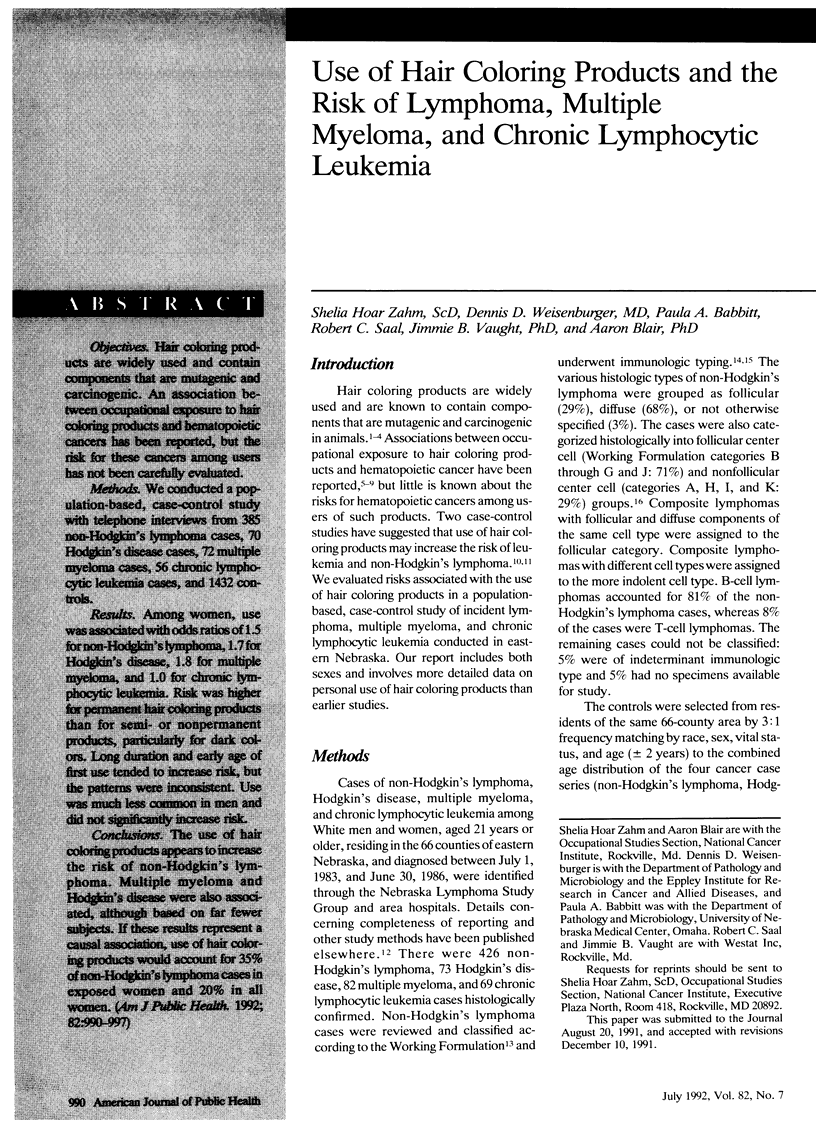
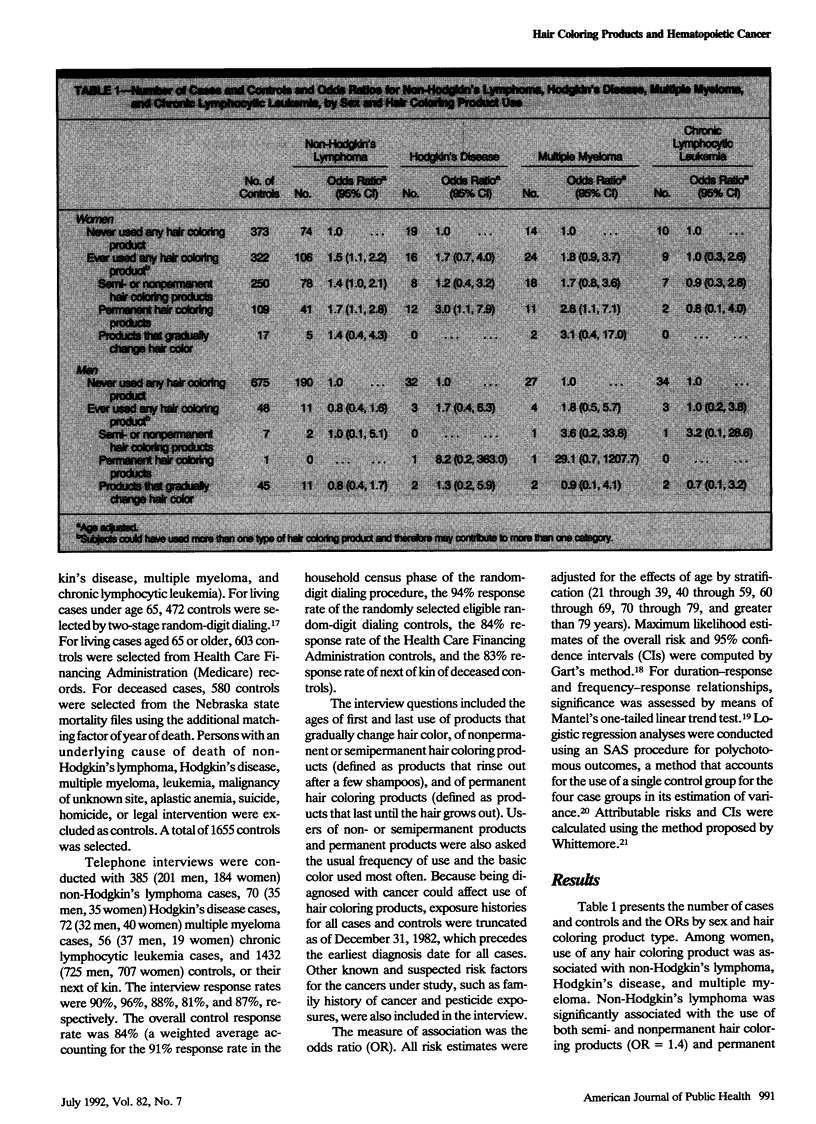
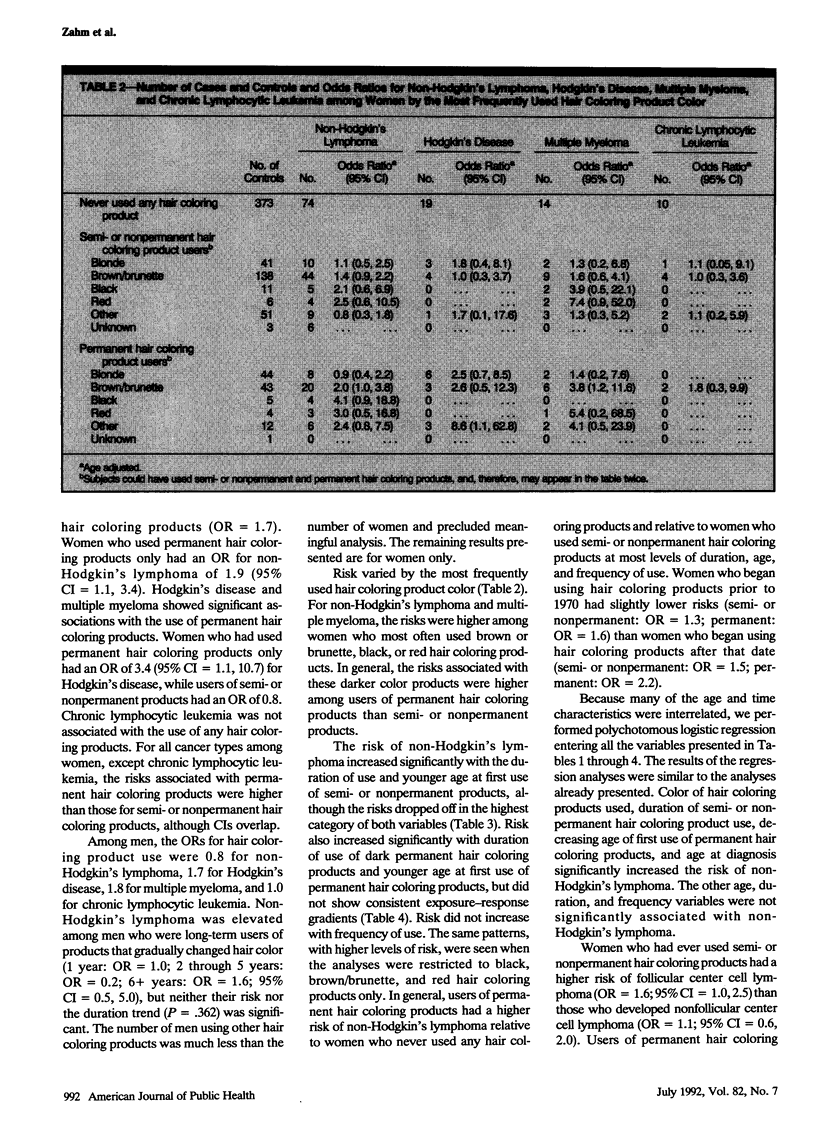
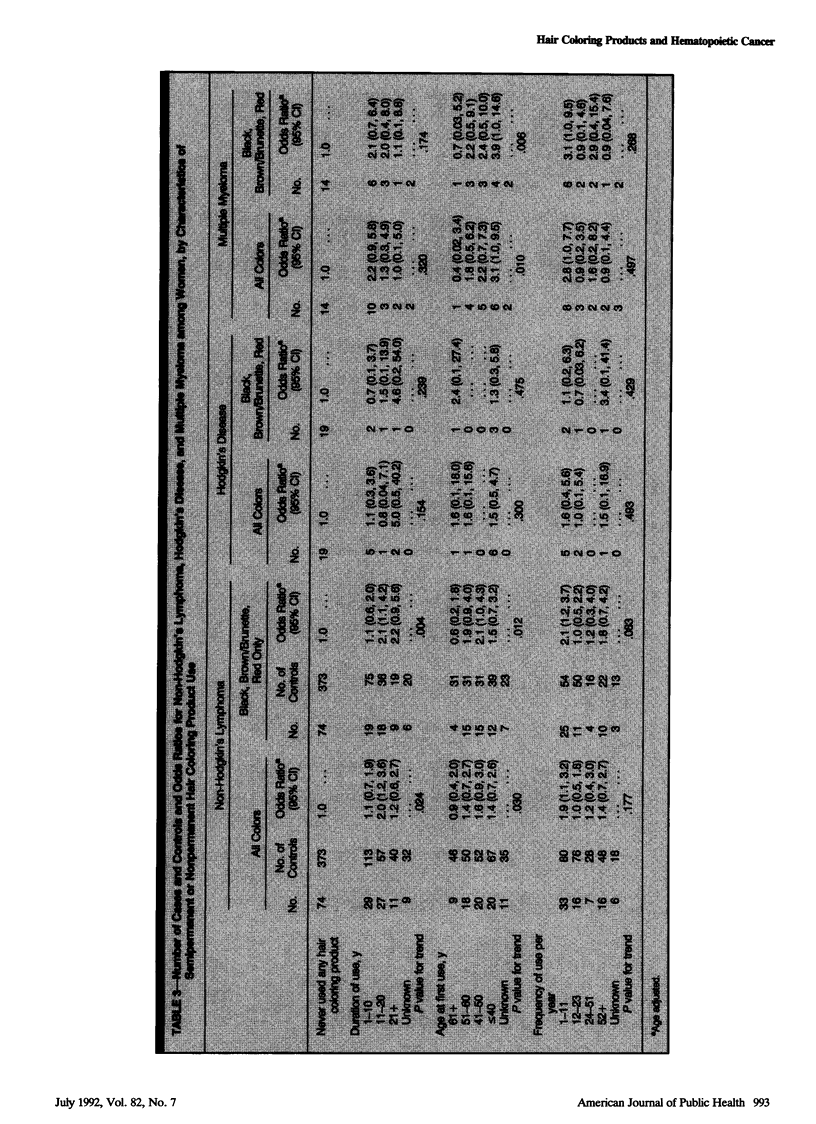
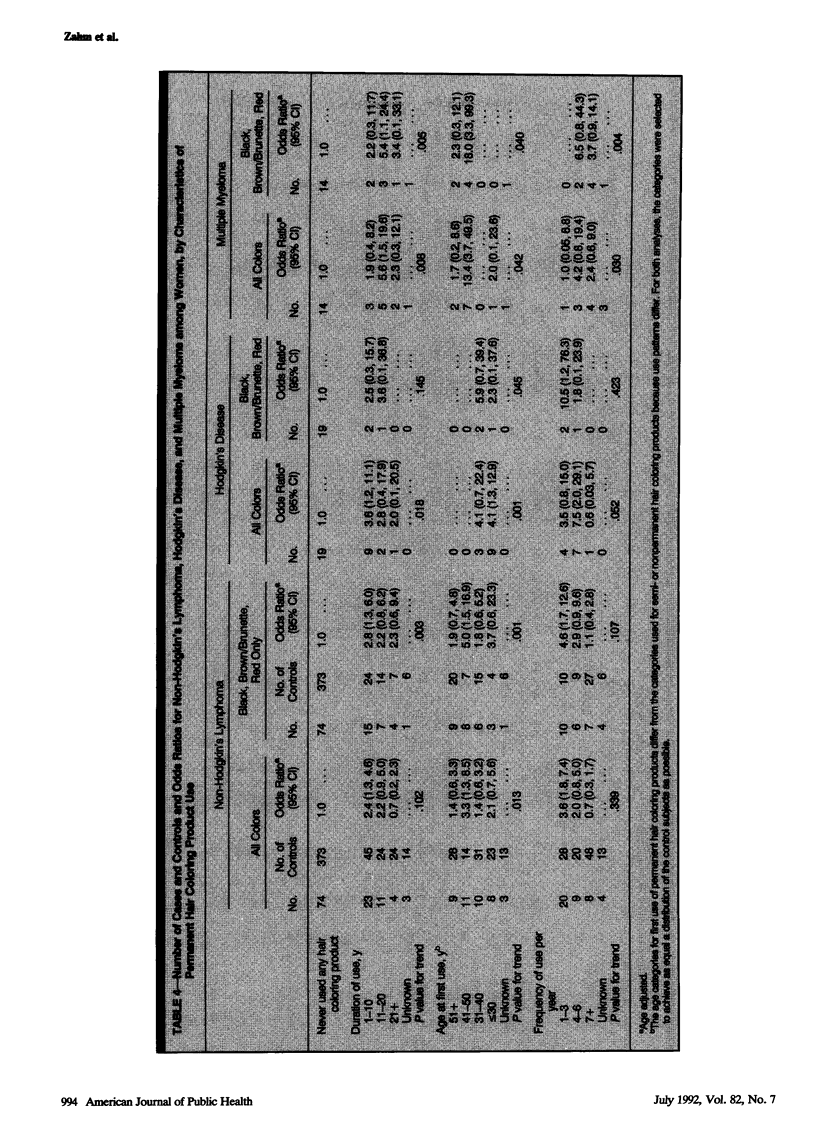
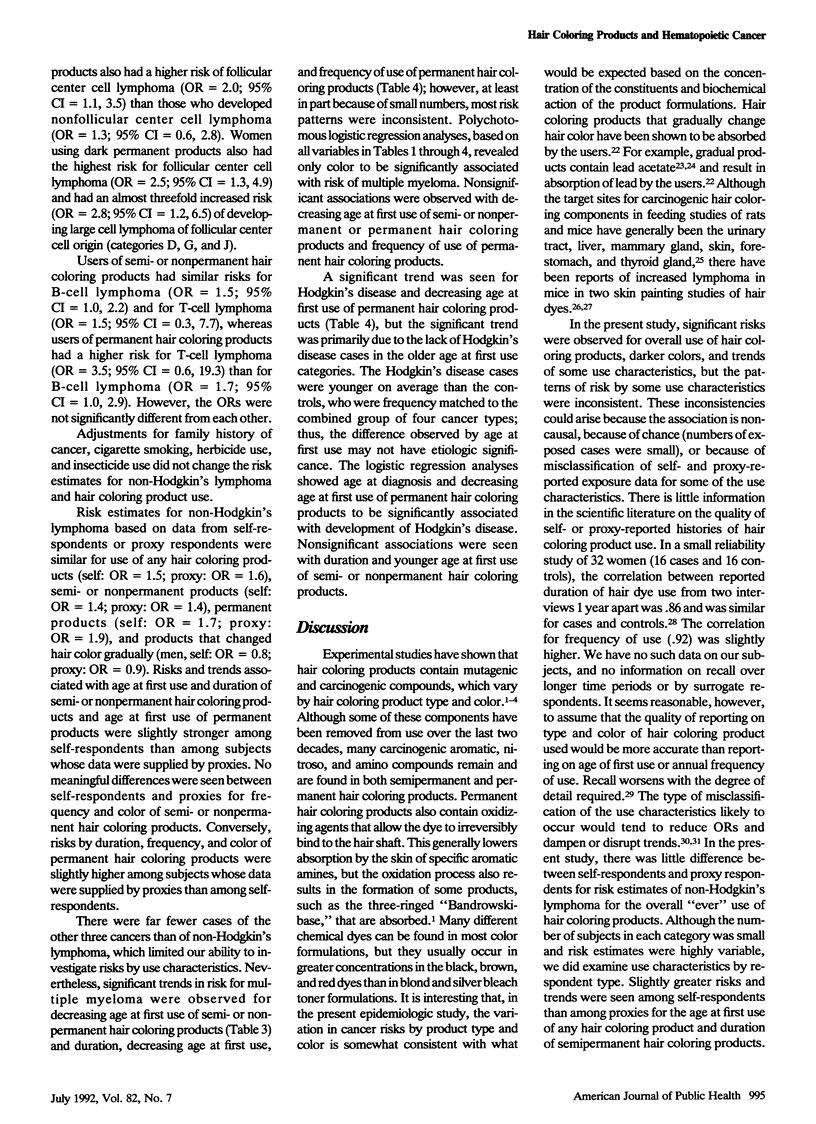
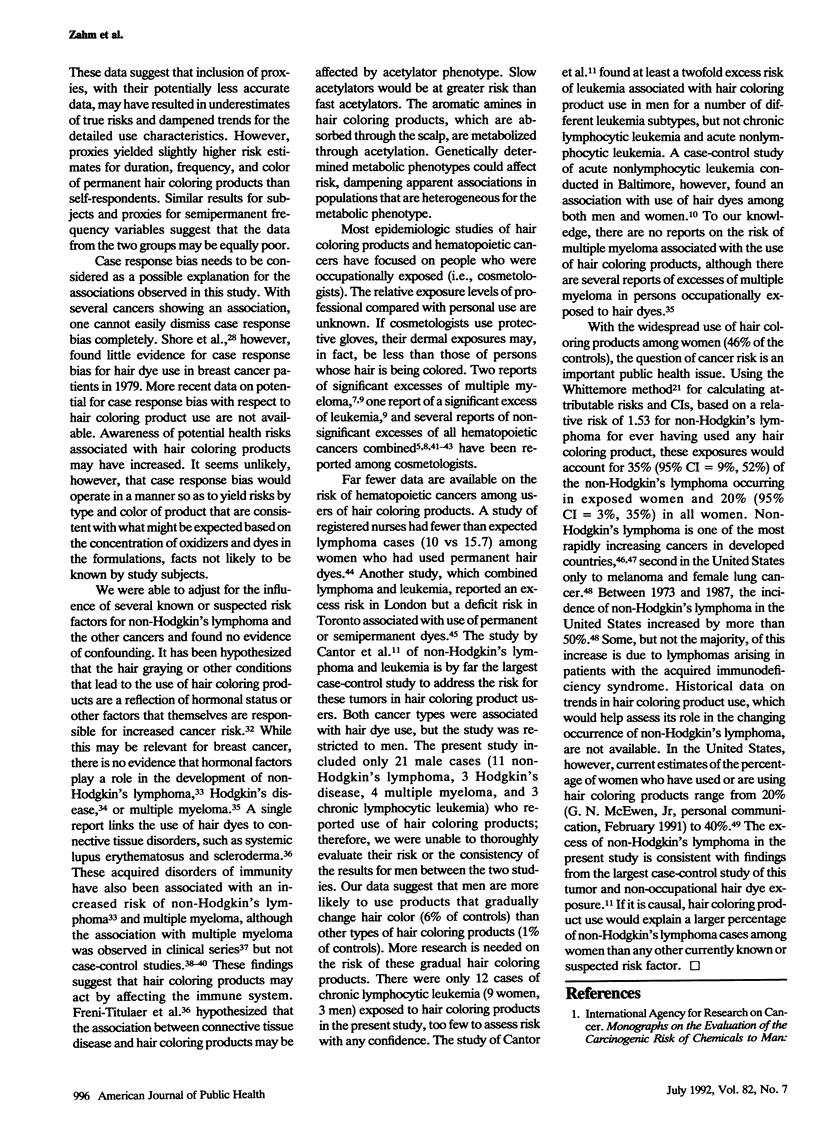
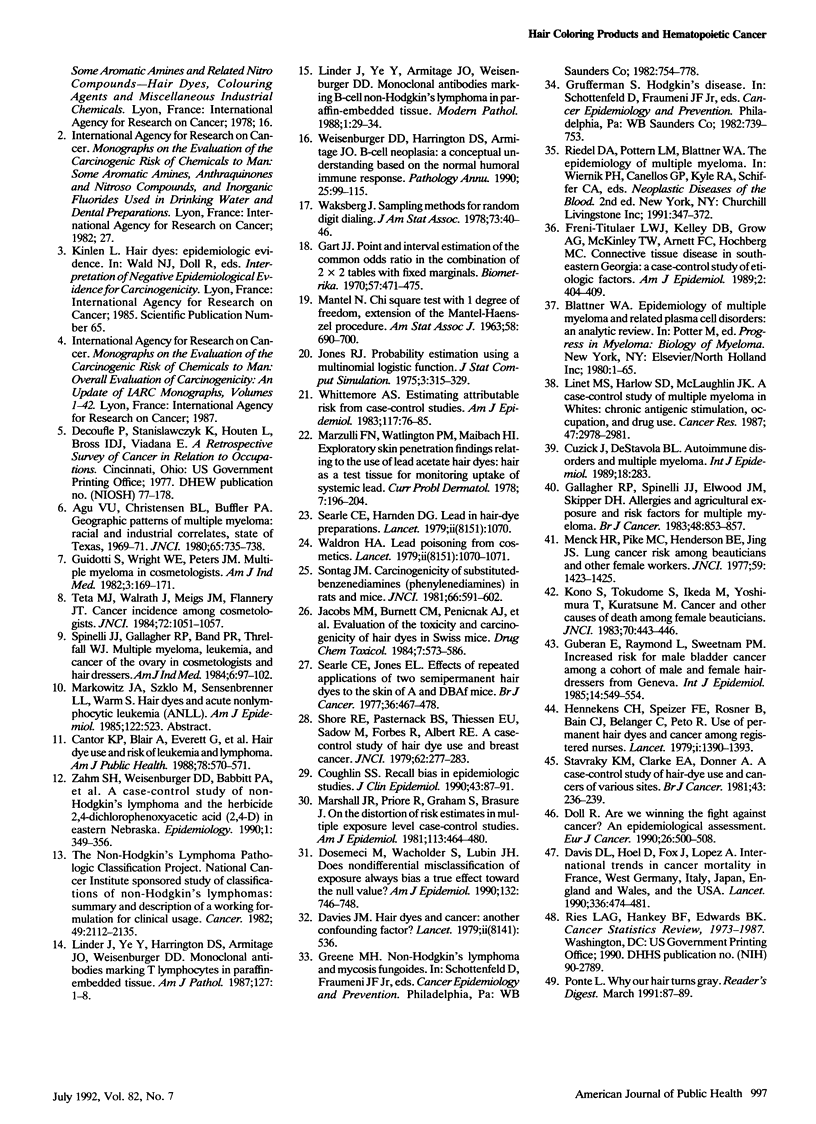
Selected References
These references are in PubMed. This may not be the complete list of references from this article.
- Agu V. U., Christensen B. L., Buffler P. A. Geographic patterns of multiple myeloma: racial and industrial correlates, State of Texas, 1969-71. J Natl Cancer Inst. 1980 Oct;65(4):735–738. doi: 10.1093/jnci/65.4.735. [DOI] [PubMed] [Google Scholar]
- Cantor K. P., Blair A., Everett G., VanLier S., Burmeister L., Dick F. R., Gibson R. W., Schuman L. Hair dye use and risk of leukemia and lymphoma. Am J Public Health. 1988 May;78(5):570–571. doi: 10.2105/ajph.78.5.570. [DOI] [PMC free article] [PubMed] [Google Scholar]
- Coughlin S. S. Recall bias in epidemiologic studies. J Clin Epidemiol. 1990;43(1):87–91. doi: 10.1016/0895-4356(90)90060-3. [DOI] [PubMed] [Google Scholar]
- Cuzick J., De Stavola B. L. Autoimmune disorders and multiple myeloma. Int J Epidemiol. 1989 Mar;18(1):283–283. doi: 10.1093/ije/18.1.283. [DOI] [PubMed] [Google Scholar]
- Davies J. M. Hair dyes and cancer: another confounding factor. Lancet. 1979 Sep 8;2(8141):536–536. doi: 10.1016/s0140-6736(79)91602-7. [DOI] [PubMed] [Google Scholar]
- Davis D. L., Hoel D., Fox J., Lopez A. International trends in cancer mortality in France, West Germany, Italy, Japan, England and Wales, and the USA. Lancet. 1990 Aug 25;336(8713):474–481. doi: 10.1016/0140-6736(90)92020-i. [DOI] [PubMed] [Google Scholar]
- Doll R. Are we winning the fight against cancer? An epidemiological assessment. EACR--Mühlbock memorial lecture. Eur J Cancer. 1990 Apr;26(4):500–508. doi: 10.1016/0277-5379(90)90025-o. [DOI] [PubMed] [Google Scholar]
- Dosemeci M., Wacholder S., Lubin J. H. Does nondifferential misclassification of exposure always bias a true effect toward the null value? Am J Epidemiol. 1990 Oct;132(4):746–748. doi: 10.1093/oxfordjournals.aje.a115716. [DOI] [PubMed] [Google Scholar]
- Gallagher R. P., Spinelli J. J., Elwood J. M., Skippen D. H. Allergies and agricultural exposure as risk factors for multiple myeloma. Br J Cancer. 1983 Dec;48(6):853–857. doi: 10.1038/bjc.1983.277. [DOI] [PMC free article] [PubMed] [Google Scholar]
- Gubéran E., Raymond L., Sweetnam P. M. Increased risk for male bladder cancer among a cohort of male and female hairdressers from Geneva. Int J Epidemiol. 1985 Dec;14(4):549–554. doi: 10.1093/ije/14.4.549. [DOI] [PubMed] [Google Scholar]
- Guidotti S., Wright W. E., Peters J. M. Multiple myeloma in cosmetologists. Am J Ind Med. 1982;3(2):169–171. doi: 10.1002/ajim.4700030207. [DOI] [PubMed] [Google Scholar]
- Hennekens C. H., Speizer F. E., Rosner B., Bain C. J., Belanger C., Peto R. Use of permanent hair dyes and cancer among registered nurses. Lancet. 1979 Jun 30;1(8131):1390–1393. doi: 10.1016/s0140-6736(79)92021-x. [DOI] [PubMed] [Google Scholar]
- Jacobs M. M., Burnett C. M., Penicnak A. J., Herrera J. A., Morris W. E., Shubik P., Apaja M., Granroth G. Evaluation of the toxicity and carcinogenicity of hair dyes in Swiss mice. Drug Chem Toxicol. 1984;7(6):573–586. doi: 10.3109/01480548409042820. [DOI] [PubMed] [Google Scholar]
- Kono S., Tokudome S., Ikeda M., Yoshimura T., Kuratsune M. Cancer and other causes of death among female beauticians. J Natl Cancer Inst. 1983 Mar;70(3):443–446. [PubMed] [Google Scholar]
- Linder J., Ye Y. L., Harrington D. S., Armitage J. O., Weisenburger D. D. Monoclonal antibodies marking T lymphocytes in paraffin-embedded tissue. Am J Pathol. 1987 Apr;127(1):1–8. [PMC free article] [PubMed] [Google Scholar]
- Linder J., Ye Y., Armitage J. O., Weisenburger D. D. Monoclonal antibodies marking B-cell non-Hodgkin's lymphoma in paraffin-embedded tissue. Mod Pathol. 1988 Jan;1(1):29–34. [PubMed] [Google Scholar]
- Linet M. S., Harlow S. D., McLaughlin J. K. A case-control study of multiple myeloma in whites: chronic antigenic stimulation, occupation, and drug use. Cancer Res. 1987 Jun 1;47(11):2978–2981. [PubMed] [Google Scholar]
- Marshall J. R., Priore R., Graham S., Brasure J. On the distortion of risk estimates in multiple exposure level case-control studies. Am J Epidemiol. 1981 Apr;113(4):464–473. doi: 10.1093/oxfordjournals.aje.a113114. [DOI] [PubMed] [Google Scholar]
- Marzulli F. N., Watlington P. M., Maibach H. I. Exploratory skin penetration findings relating to the use of lead acetate hair dyes. Hair as a test tissue for monitoring uptake of systemic lead. Curr Probl Dermatol. 1978;7:196–204. [PubMed] [Google Scholar]
- Menck H. R., Pike M. C., Henderson B. E., Jing J. S. Lung cancer risk among beauticians and other female workers: brief communication. J Natl Cancer Inst. 1977 Nov;59(5):1423–1425. [PubMed] [Google Scholar]
- Searle C. E., Harnden D. G. Lead in hair-dye preparations. Lancet. 1979 Nov 17;2(8151):1070–1070. doi: 10.1016/s0140-6736(79)92461-9. [DOI] [PubMed] [Google Scholar]
- Searle C. E., Jones E. L. Effects of repeated applications of two semi-permanent hair dyes to the skin of A and DBAf mice. Br J Cancer. 1977 Oct;36(4):467–478. doi: 10.1038/bjc.1977.216. [DOI] [PMC free article] [PubMed] [Google Scholar]
- Shore R. E., Pasternack B. S., Thiessen E. U., Sadow M., Forbes R., Albert R. E. A case-control study of hair dye use and breast cancer. J Natl Cancer Inst. 1979 Feb;62(2):277–283. [PubMed] [Google Scholar]
- Sontag J. M. Carcinogenicity of substituted-benzenediamines (phenylenediamines) in rats and mice. J Natl Cancer Inst. 1981 Mar;66(3):591–602. [PubMed] [Google Scholar]
- Spinelli J. J., Gallagher R. P., Band P. R., Threlfall W. J. Multiple myeloma, leukemia, and cancer of the ovary in cosmetologists and hairdressers. Am J Ind Med. 1984;6(2):97–102. doi: 10.1002/ajim.4700060204. [DOI] [PubMed] [Google Scholar]
- Stavraky K. M., Clarke E. A., Donner A. A case-control study of hair-dye use and cancers of various sites. Br J Cancer. 1981 Feb;43(2):236–239. doi: 10.1038/bjc.1981.35. [DOI] [PMC free article] [PubMed] [Google Scholar]
- Teta M. J., Walrath J., Meigs J. W., Flannery J. T. Cancer incidence among cosmetologists. J Natl Cancer Inst. 1984 May;72(5):1051–1057. [PubMed] [Google Scholar]
- Waldron H. A. Lead poisoning from cosmetics. Lancet. 1979 Nov 17;2(8151):1070–1071. doi: 10.1016/s0140-6736(79)92462-0. [DOI] [PubMed] [Google Scholar]
- Weisenburger D. D., Harrington D. S., Armitage J. O. B-cell neoplasia. A conceptual understanding based on the normal humoral immune response. Pathol Annu. 1990;25(Pt 1):99–115. [PubMed] [Google Scholar]
- Whittemore A. S. Estimating attributable risk from case-control studies. Am J Epidemiol. 1983 Jan;117(1):76–85. doi: 10.1093/oxfordjournals.aje.a113518. [DOI] [PubMed] [Google Scholar]
- Zahm S. H., Weisenburger D. D., Babbitt P. A., Saal R. C., Vaught J. B., Cantor K. P., Blair A. A case-control study of non-Hodgkin's lymphoma and the herbicide 2,4-dichlorophenoxyacetic acid (2,4-D) in eastern Nebraska. Epidemiology. 1990 Sep;1(5):349–356. doi: 10.1097/00001648-199009000-00004. [DOI] [PubMed] [Google Scholar]


